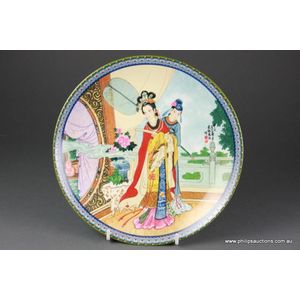Chinese 'Beauties of the Red Mansion' Plate Collection
You must be a subscriber, and be logged in to view price and dealer details.
Subscribe Now to view actual auction price for this item
When you subscribe, you have the option of setting the currency in which to display prices to $Au, $US, $NZ or Stg.
- Jingdezhen Kilns - The Jingdezhen kilns are a series of kilns located in Jingdezhen, a city in the Jiangxi province of China, which have been producing high-quality porcelain since the Han Dynasty (206 BCE?220 CE). The city's location in a valley surrounded by mountains provided it with abundant supplies of high-quality kaolin clay, which is essential for the production of porcelain.
Jingdezhen quickly became one of the most important centres of porcelain production in China, and its porcelain was highly prized by the imperial court and exported to markets throughout Asia and Europe. During the Song Dynasty (960-1279 CE), the kilns began to produce blue-and-white porcelain, which became a hallmark of Jingdezhen porcelain production.
In the Ming Dynasty (1368-1644 CE), Jingdezhen porcelain production reached its peak, with the kilns producing a wide range of objects, from bowls and vases to figurines and architectural tiles. The porcelain produced during this time was noted for its fine quality, translucent white body, and delicate decoration. The kilns also developed new decorative techniques, such as the use of overglaze enamels and famille-verte ("green family") decoration.
During the Qing Dynasty (1644-1912 CE), the Jingdezhen kilns continued to produce porcelain, but the market for porcelain began to shift towards export markets in Europe and the Americas. Jingdezhen porcelain was highly prized by European collectors and royalty, and the kilns produced many objects specifically for export, such as tea sets, dinnerware, and decorative objects.
Today, the Jingdezhen kilns continue to produce porcelain, although the industry has faced challenges from modern manufacturing techniques and competition from other countries. Nevertheless, the city remains an important center of porcelain production and has become a popular destination for tourists interested in traditional Chinese crafts and culture.
This item has been included into following indexes:
Visually similar items

A Cantonese famille rose charger, late Qing Dynasty, 19th-20th century, delightfully decorated with fifteen children and a teacher, and engaged in various outdoor pursuits, carrying objects, teasing, climbing trees, in raised enamel colours with a pink and

Antique continental porcelain lidded box, with handpainted floral decoration, with applied gilded Bow to lid. diameter 19 cm.

Poole pottery collectors club charger painted by Gwen Haskins tall ship 'Primrose Poole 1588', 1976 32 cm dia

Roy Cowan, charger, incised initials & dated ?Û÷80, 36 cm dia (repair to rim)
